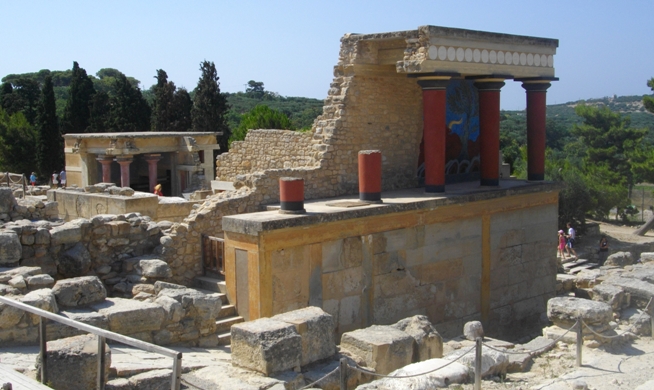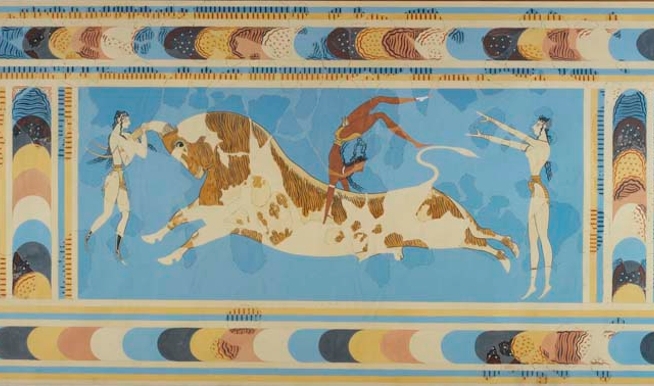The Evans Connection Part 2: The Minoans Created
I continue the story which I began in my previous post – Part1: The Minoans Discovered – to show how the British archeologist, Sir Arthur Evans, made his own particular interpretation of the ancient Minoan civilization so popular, and what consequences this popularity was to have.
Evans ‘Creates’ the Minoans
As I discussed in my previous post, Evans’ intellectual background, and the academic and political climate in which he lived shaped his desire to discover a particular type of Aegean prehistory. The archaeological remains that he uncovered matched his own ideas about the Minoans so well, partly because they were interpreted and reconstructed in the light of his preconceptions.
The impact of Evans’ vision can be seen at its most concrete (literally) at the site of Knossos, where the temporary structures which sheltered the crumbling remains were transformed into a large-scale reconstruction in reinforced concrete of elements of the ‘palace’. Evans called these his “reconstitutions”, and stressed that they were all based on archaeological evidence – the upper storeys were extrapolated from surviving archaeological traces, while the decoration and style was based on that seen in the Minoan frescoes. This approach to restoration was controversial, both when it was first completed, and today, because it goes beyond the archaeological evidence and is so visually intrusive. Visitors to Knossos often remark on the surprisingly modern, Art Nouveau style of Minoan architecture which is, at least to some extent, a product of Evans and his team working within their contemporary style.

The Palace of Knossos. The portico of the North Entrance Corridor restored in 1930 with Bull fresco. (photo B. Akrigg, 2011)
Reconstitution created a vision of the Bronze Age past which remains one of the best known images of the ancient Minoans. Although it has been much criticized, it also captured the public’s imagination, and visitors to the excavations included academics, artists and soldiers of many nationalities. The famous dancer Isadore Duncan was inspired to perform as soon as she saw the remains at Knossos in 1910 (to the disapproval of Duncan Mackenzie).
As well as the ‘reconstitution’ of the architecture, Evans wanted the objects he found restored to best effect. He employed a father and son team of Swiss artists and archaeological illustrators, Emile (père) and Emile (fils) Gilliéron. They were to work at Knossos for 30 years, recreating the art of the Minoans, often from little physical evidence. The frescoes of Knossos, probably the best known images of the Minoan art today, were very much the creation of the Gilliérons, pieced together from scattered scraps of ancient fresco, sometimes from different areas of the palace, to create a heavily restored whole. Several of these restorations are now considered inaccurate, and some example are discussed by Sean Hemmingway in a blog post about the 2011-2012 Metropolitan Museum of Art exhibition Historic images of the Greek Bronze Age, The reproductions of E. Gilliéron and Son.
Not only did Evans work to bring the physical remains of Knossos to life, he was also tireless in presenting his discoveries to a wide audience, both specialist and the general public, through lectures, exhibitions and articles. In 1903 he first put on an exhibition of his Minoan finds, illustrations, and casts, at the Royal Academy of Arts in London, and a second exhibition at the Royal Academy called British Archaeological Discoveries in Greece and Crete 1886-1936, to celebrate the 50th anniversary of the British School at Athens in 1936, featured a room of Minoan material, including an illustration of the ROM Goddess (described in the exhibition catalogue p.17). While these lectures and exhibitions made his discoveries accessible to everyone, his huge publication The Palace of Minos would ensure his pre-eminence in the academic world.
It is hard to find specific examples of how much Evans’ discoveries seduced and fascinated the popular imagination. Some believe that the art of the period, particularly the early work of the Surrealists were influenced by the Minoan past. But this was more a debt to the ideas of the mythological past and society, than to the physical remains. However, it is true that a generic Greek Bronze Age began to feature in art and in fashion, inspired by the popularity of the discoveries of both Schliemann and Evans. In 1906, the Spanish designer Mario Fortuny created the ‘Knossos’ scarf, a signature piece presumably directly motivated by the discoveries on Crete. In the academic world, a young Michael Ventris was so enthused by hearing Evans lecture on the Minoans that it decided his future career. This would eventually lead him to decipher the Bronze Age Linear B script that had first attracted Evans to the site of Knossos.
From Replicas to Fakes
The Gilliérons, father and son, were doing more than simply restoring the Knossos frescoes and small finds. They, and other archaeological restorers, also produced replicas of the material for those eager to own their own piece of the Minoan past. This practice was approved by Evans, and it offered a way of sharing the artefacts which could not leave Crete without intending to deceive. The Gilliérons’ reproductions of both the Minoan material discovered by Evans, and the Mycenaean objects discovered by Schliemann were bought by many museums, including the Metropolitan, to enhance their collection. Evans himself displayed replicas in the 1936 Royal Academy exhibition, including a reproduction of a faience snake goddess created by Halvor Bagge, a Danish artist who had restored the original artifact.
As well as official replicas, by the 1920s there was also a thriving industry in manufacturing fake Minoan artefacts. Cretan ‘factories’ which produced forgeries were apparently known to the police, to museum authorities, such as the director of the Heraklion museum, and even to other European academics. The craftsmen making these forgeries were the same workmen whom Evans employed as excavators and restorers at Knossos. These men were ideally placed to create fakes based on the genuine Minoan artefacts they were finding in the excavations. Indeed, some have suggested that the Gilliérons themselves were organizing and directing the production of the forgeries. In memoirs and anecdotes, several archaeologists visiting or working in Crete record eyewitness accounts of these forgers at work, but the stories can be frustratingly vague and incorrect in their details.
In Crete in the early years of this century I was stopping with Arthur Evans…and one day he got a message from the police at Candia [modern Heraklion] asking him to come to the police station, so we went together – he, Duncan Mackenzie…and myself…
Evans had for many years employed two Greeks to restore the antiquities which he had found. They were extraordinarily clever men – and old man and a young one – and he had trained them, and they had worked under the artist whom he employed there, and they had dome wonderful restorations for him. Then the old man got ill and at last the doctor told him he was going to die….
“Right,” he said. “Send for the police.”….He insisted, and they sent for the police…
“Now I can tell you,” said the sick man. “I’m going to die, so I’m all right, but for years I’ve been in partnership with George Antoniou, the young fellow who works with me for Evans, and we have been forging antiquities…..we’ve sold a statuette of gold and ivory which was supposed to be a Cretan one to the Candia Government Museum, and that’s a criminal offense. George is a scoundrel and I hate the fellow, and I’ve been waiting for this moment to give him away. Go straight to his house and you’ll find all the forgeries and all our manufacturing plant there.”
The police went, they raided, and they found exactly what he said, and they asked Evans to come and look, and I never saw so magnificent a collection of forgeries as those fellows had put together.
There were things in every stage of manufacture. For instance, people had been recently astounded at getting what they call chryselephantine statuettes from Crete; statuettes of ivory decked out with gold – the is one in the Boston Museum and one at Cambridge, and one in the Cretan Museum at Candia. These men were determined to do that sort of thing, and they had got everything, from plain ivory tusk and then the figure rudely carved out, then beautifully finished, then picked out with gold. And then the whole thing was put into acid, which ate away the soft parts of the ivory giving it the effect of having been buried for centuries. And I didn’t see anyone could tell the difference!
Sir Leonard Woolley 'As I seem to Remember' (London, 1962) p. 21-23
While this account shows that fake Minoan ivory figurines were being produced, it is inaccurate in several details. The ‘Minoan’ statuette in Cambridge is made from stone, not ivory, while the only ivory figurines in Candia museum (modern Heraklion museum) were all properly excavated, and so should be genuine. Only Boston Museum possesses an ivory figurine that is a suspected fake, and there were already other stories circulating about this piece. In a letter from the ROM archives, Lacey Caskey, curator of the Boston Museum of Fine Arts, recounts an anecdote told to him by Doro Levi, excavator of the Minoan ‘palace’ at Phaistos on Crete.
He accompanied Marinatos to the bedside(deathbed?) of ‘Manolaki’. Marinatos had photographs of sundry doubtful Minoan statuettes, some or all of which Manolaki “recognised” as his work. He included our statuette [the Boston Snake Goddess] and said that he had made it from a design furnished by Gilliéron the elder out of ancient pieces of ivory obtained from Evans’s excavations at Knossos. Manolaki also said that he used his own daughter’s face as a model for the face of the snake goddess.….
letter from Lacey Caskey (Curator of Boston, MFA) to Homer Thompson (ROM curator), 22nd May 1940
The story of the Boston Snake Goddess is told in detail by Kenneth Lapatin in his 2002 book Mysteries of the Snake Goddess. Lapatin also lists more than ten other goddess figurines that he believes to be fakes, including the ROM ‘Minoan’ goddess. One of the reasons these figurines are suspect is that there is no evidence that they were excavated in controlled archaeological excavations, such as those at Knossos. Yet Evans still believed many of them to be genuine. Ironically, it is probably precisely because of Evans’ vision of the Minoans that some of the fakes were designed and created, and it is possible that sometimes the people making the fakes had a very good idea of whom they were targeting – Evans himself.
Only during the years of war 1915-1918 did ivory statuettes richly embellished with gold “from Crete” first come to light. These skillfully produced works always had to fit excellently with the results of Evans’ research regarding Minoan religion. And he had no doubts as to their genuineness, because – as he wrote to me once – nobody yet had knowledge of the still unpublished results. That men to whom he must, after all, have indicated some of those results would repay his benevolence over many years in such a malevolent way was to a man of his character wholly incomprehensible….
Georg Karo (director of the German Archaeological Institute, Athens) 'Greifen am Thron' (Baden-Baden 1959) p. 41-42.
Translated from the German by Lapatin

The ‘Taureador’ Fresco, from Knossos in a watercolour reproduction by Piet de Jong, based on reconstruction by Emile Gilliéron (père) (ROM image)
This brings us back to the ROM ‘Minoan’ Goddess. Lapatin has made an ingenious suggestion as to why the ROM goddess looks the way she does. In Evans’ vision of Minoan society, unlike in his own society, gender roles were inverted and women played important roles. Evans was particularly taken with the idea that women as well as men took part in the ritual sport of bull-leaping, and he identified women in several of the depictions. The best example is the Bull-Leaping fresco (the ‘Taureador’ fresco) from Knossos, in which he believed the white-skinned acrobatic figures to be female (although flat-chested), in keeping with the ancient Egyptian artistic convention of depicting women with white skin. This interpretation has been questioned, since several male figures with white skin have been identified in Cretan frescoes. However, according to Lapatin’s theory, forgers decided to make an object that would appeal to Evans and confirm his beliefs about female bull-leapers. First they made a figurine which was flat-chested and had upraised arms that matched the posture of the Knossos Bull-leaper Fresco depictions. But Evans identified this figurine (now in the Seattle Art Museum) as a Boy-God and suggested it was once paired with the Boston Snake goddess. On a second attempt, the forgers made sure there was no room for misidentification – this time the figurine wore the costume of a bull-leaper and was unmistakeably female!
There are difficulties with this hypothesis, particularly with identification of the Seattle ‘boy-god’ as an acrobat, given the unusual but prominent headdress, and I shall be discussing all the ivory figurines, genuine and suspect, in a later post. However, it is still fair to say that Evans probably knew those responsible for creating Minoan fakes, and the publicity he generated around his discoveries did much to create a demand for replicas, and indeed for fakes.

Minoan Lines Ferries use the Priest-King, a fresco from Knossos, as their logo, seen here on the chimney (photo supplied by FreeFoto.com)
Legacy of the Minoans
Evans was not alone in using the Minoan remains to uphold a particular perspective of the past. Ever since their discovery, the ‘story’ of the Minoans has been continually re-imagined and re-invented, whether through Evans’ interpretation, through ancient myths, or the artefacts themselves. Versions of the Minoans have entered the fields of psychoanalysis, art, feminism, modernist literature and neo-paganism. Archaeological excavations throughout Crete continue to expand and refine our knowledge of the Aegean Bronze Age. Today, the archaeological site of Knossos is a major Greek tourist attraction, with visitor numbers rivaling the Athenian Acropolis. Cretan companies ranging from builders to cruise ships use the name and the symbols of the Minoans. In the opening ceremony of the 2004 Athens Olympics (captured on many YouTube videos and blogs) living tableaux of Minoan artefacts were at the head of the procession of ancient Greek artistic achievements – a controversial claim to continuity which might have troubled Evans (and many modern academics).
Further Reading
C.L. Cooper (Kate Cooper), 'Biography of the Bull-Leaper: A 'Minoan' Ivory Figurine and Collecting Antiquity', in Cooper C.L. (ed) New Approaches to Ancient Material Culture in the Greek & Roman World (Leiden: Brill, MGR 27, 2021)
A.L.D’Agata, ‘The many lives of a ruin: History and Metahistory of the Palace of Minos’ in Olga Kryszkowska (ed.) Cretan Offerings: studies in honour of Peter Warren (London, British School at Athens Studies 18, 2010), p. 57-69
Cathy Gere, Knossos and the Prophets of Modernism (Chicago: 2009)
Kenneth Lapatin, Mysteries of the Snake Goddess. Art, Desire and the Forging of History (Boston, New York: 2002)
Nicoletta Momigliano & Yannis Hamilakis (eds), Archaeology and European Modernity: producing and consuming “the Minoans” (Creta Antica 7, Padua: 2006)
John Papadopoulos, ‘Minoans and Modernity’ in Journal of Mediterranean Archaeology 18 (2005)
